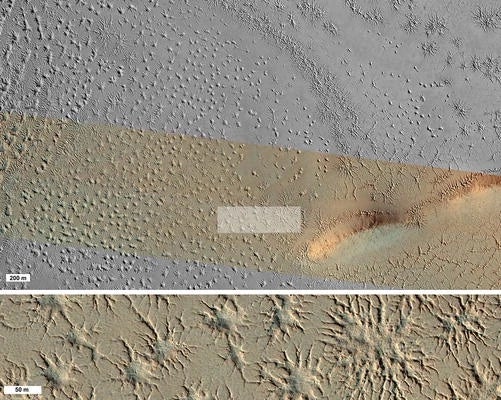This creepy-crawly topographical feature forms during the martian spring season.

Martian ‘spiders’ imaged by the ESA’s ExoMars Trace Gas Orbiter. Credit: ESA/TGO/CaSSIS
One of the European Space Agency’s (ESA) Mars explorers, the ExoMars Trace Gas Orbiter (TGO), studies the martian atmosphere and, apparently, “spiders” too.
Recently, ESA’s TGO released an image of strange spiderlike topographical features found on the southern polar region of Mars, along with an explanation behind their formation. Another strange, photographed feature was named “Inca City” after its appearance.
These spider features come to fruition on the surface of the South Pole during the Mars’ springtime. As temperatures rise and rays of sunlight touch the ice layers of carbon dioxide that form during the colder seasons, the accumulated warmth at the bottom of the layer causes the carbon dioxide to turn into gas. The gas eventually escapes by bursting through the slabs of ice. The gas pressure is built up enough to travel through the cracks — while mixing with dark dust — and sprouts out to form a fountain or geyser. The material then falls back down and settles on the surface.
This phenomenon, also known as martian geysers, creates dark crackle features about 45 meters to 1 kilometer wide. Although, when the gas cannot escape, it bubbles beneath the frozen surface and, instead of bursting, it forms the spiders underneath the icy layers.

Inca City
Most of the martian spiders tend to be near the outside of the Inca City area. This region is scattered with hills and plateaus that look like the ancient Incan ruins on Earth and was promptly named so. The martian Inca City was first discovered by NASA’s Mariner 9 probe in 1972.
ESA’s Mars Express took a photo of Inca City, where the cluster of spiders appears like an ink stain on Mars’ surface at the bottom left of the image. In Inca City, researchers identified two types of spider structures: One is reminiscent of spiders with a fat center and short legs, the second is a spider with a larger center and long, thin legs. Some of these spider features can also interconnect, forming a scalelike pattern.

The same geyser process can also form fanlike features called seasonal polar fan-shaped deposits. However, these shapes get their striking shape from near-surface winds on the Red Planet. Unlike the permanent spiders mentioned above, the fan shapes will disappear once the martian summer begins.




